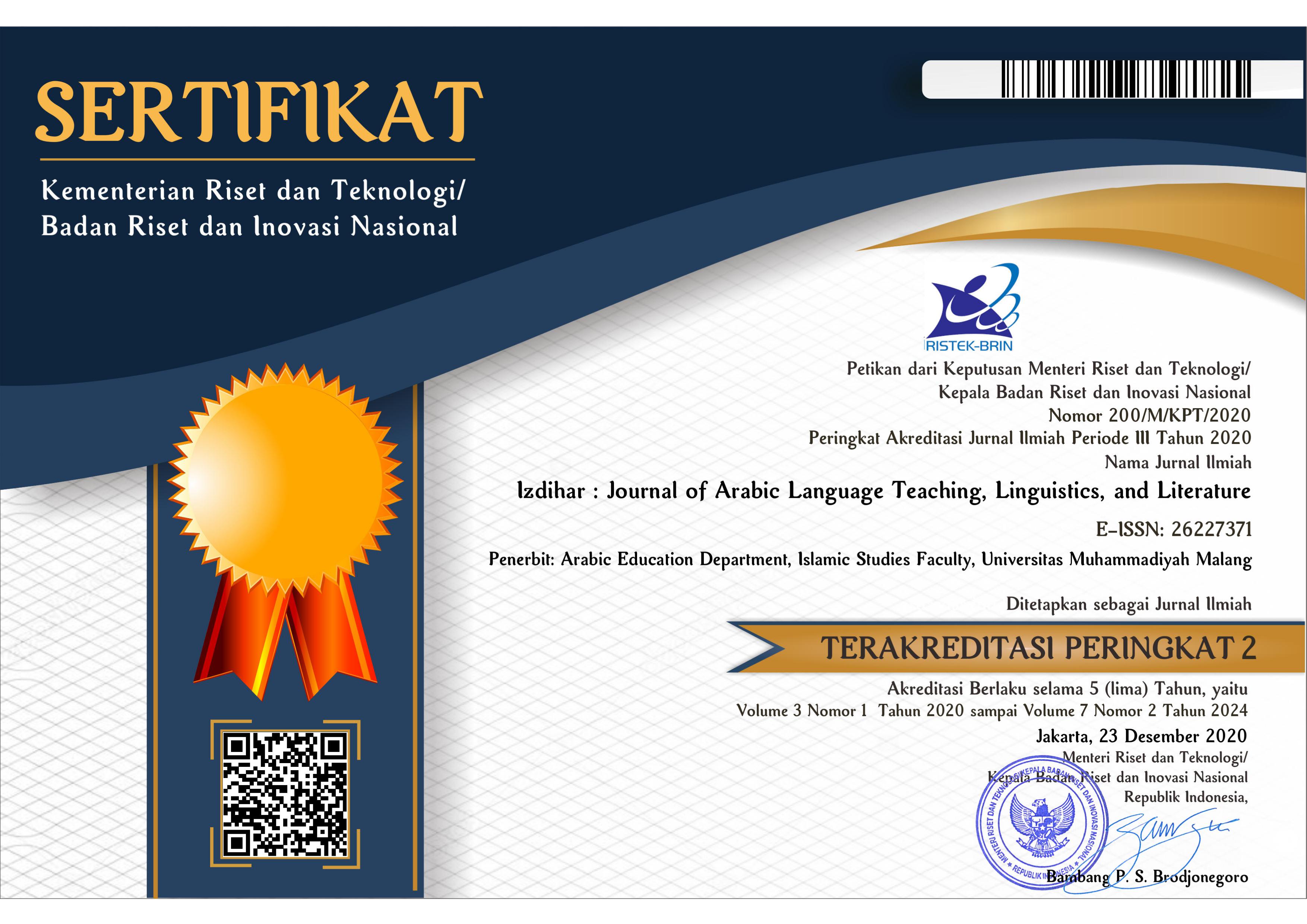Nahwu Learning Through Banjar Culture with Syahid Table in South Kalimantan
DOI:
https://doi.org/10.22219/jiz.v5i3.23401Keywords:
Nahwu; Learning; Culture; Banjarese;Abstract
The purpose of this study were to reveal the cultural aspects of Nahwu learning at Islamic Boarding School, South Kalimantan. This research was case study research with a qualitative approach carried out at Darul Ilmi Islamic Boarding School for Girl, South Kalimantan. The results of this study showed the cultural aspects of Nahwu learning at Islamic Boarding School, South Kalimantan, were: - The use of Banjarese Malay in explaining the Nahwu rules, the strategy of the Syahid, the explanation of the Syahid and the translation of the characteristics of Banjar, - the Syahid in the Banjarese language in the form of a concept a graphic image table consisting of Syahid, kalimat, alamat, hukum, mahal, liys tengah, a’mil, alamat and liys akhir, where each table contains sentence functions from examples related to the topic being studied. - translation of banjar characteristics include: “Bermula” the marker for “مبتدأ”, “yaitu” the marker for “خبر”, “ulih” the marker for “فاعل”, “akan” the marker for “مفعول” The affix “nya” the marker for “إضافة”, “hal keadaan” the marker for “حال”, and “berbilang” of markers for “جمع”. This study indicated that nahwu learning based on regional culture by combining concept learning conditions and the use of the mother tongue contributes to facilitating and helping students' difficulties in learning Nahwu.
Downloads
References
Aliyah, Aliyah. 2018. “Pesantren Tradisional Sebagai Basis Pembelajaran Nahwu Dan Sharaf Dengan Menggunakan Kitab Kuning.” Al-Ta’rib : Jurnal Ilmiah Program Studi Pendidikan Bahasa Arab IAIN Palangka Raya 6, no. 1 (Juni): 1–25. https://doi.org/10.23971/altarib.v6i1.966.
Abdurrauf, M. (2003), al-Marja' fi Ta'lim al-Lughah al-Arabiyyah lil Ajanib min an-Nadhoriyah ila at-Thathbiq. Maktabah Wahbah.
Annaqah, M. K., & Thu’aimah, A. R., (2003), Tharaiq Tadris al-Lughah al-A’rabiyyah li Ghairi an-Nathiqin biha. Mansyurat almunadhomah al-Islamiyah li at-Tarbiyah wa al-Ulum ast-Staqofah.
Ardiansyah, Ade Arip, dan Azhar Muhammad. 2020. “Implementation of Integrative Arabic Grammar (Nahwu & Sharaf) Curriculum in Islamic Boarding School.” Izdihar : Journal of Arabic Language Teaching, Linguistics, and Literature 3, no. 3 (Desember): 211–28. https://doi.org/10.22219/jiz.v3i3.13264.
Boubaya, R. 2020. “Analysis of Arabic Cultural Aspects in Three Main Arabic Textbooks.”. California University.
Chaer, Abdul. 2009. Sintaksis bahasa Indonesia: pendekatan proses. Cet. 1. Rineka Cipta.
Creswell, John W. 2013. Qualitative inquiry and research design: choosing among five approaches. 3rd ed. SAGE Publications.
Devianty, Rina. 2017. “Bahasa Sebagai Cermin Kebudayaan.” Jurnal Tarbiyah 24, no. 2 (Desember). https://doi.org/10.30829/tar.v24i2.167.
Ellis, R. 1989. Understanding Second Language Acquisition. Oxford. University Press.
Fakhruddin, 1992, Thuruq at-Tadris al-Khashah bi al-Lughah al-A’rabiyyah al-Islamiyah, A’lim al-Kutub
Fransisca, Tony. 2015. “Konsep I’rab dalam Ilmu Nahwu:” al Mahāra: Jurnal Pendidikan Bahasa Arab 1, no. 1 (Desember): 79–100. https://doi.org/10.14421/almahara.2015.011-04
Gagne, R.B. 1984. The Conditions of Learning. New York: Holt, Rinehart and Winston. http://garfield.library.upenn.edu/classics1984/A1984SQ70000001.pdf.
Gibāri, A., & Khalid, M. (2009), al-Baḥṡ an-Nau’i fi at-Tarbiyyah wa al-’Ulum an-Nafs, Maktabah al-Mujtama’ al-A’rabi. https://doi.org/10.14421/almahara.2015.011-04.
Lado, Robert. 1964. . . Language teaching : a specific approach. Mc Graw hill Publishing.Co.Ltd.
Machmudah, Umi, dan Abdul Wahab Rosyidi. 2022. “Bearded Translation: The Study of Indonesian Islamic Culture and Its Role in Character Building.” Dalam , 74–80. https://www.scitepress.org/Link.aspx?doi=10.5220/0009916500740080.
Maharani, Tisa, dan Endang Setiyo Astuti. 2018. “Pemerolehan Bahasa Kedua dan Pengajaran Bahasa dalam Pembelajaran BIPA.” Jurnal Bahasa Lingua Scientia 10, no. 1 (Juni): 121–42. https://doi.org/10.21274/ls.2018.10.1.121-142.
Miles, M. B, dan M. Huberman. 1992. Analisis data Kualitatif. Diterjemahkan oleh Tjetjep Rohedi Rosidi. Universitas Indonesia.
Musthofa, Qareebullah Babkr. 2018. “Qawaid an-Nahwu wa Atsaruha fi Ta'lim al-Lughah al-A'rabiyah fi Indonesia.” Izdihar : Journal of Arabic Language Teaching, Linguistics, and Literature 1, no. 1 (September): 1–24. https://doi.org/10.22219/izdihar.v1i1.6560.
Omar, Tawfiq. 2017. “Culture and Second Language Aquisition: Arabic Language as a Model.” European Scientific Journal, ESJ 13, no. 2 (Januari): 159–159. https://doi.org/10.19044/esj.2017.v13n2p159.
Qomariah, Rafiatun Nazah, Syaifuddin Ahmad Hussein, dan Faisal Mubarak. 2018. “Binyah Al-Kalimât fî Al-Lughatain Al-’Arabiyyah wa Al-Indûnîsiyyah wa Wazhîfatuhâ fî Ta’lîm Al-Lughah Al-’Arabiyyah.” Arabiyat : Jurnal Pendidikan Bahasa Arab dan Kebahasaaraban 5, no. 1 (Juni): 171–94. https://doi.org/10.15408/a.v5i1.7267.
Rini, Rini. 2019. “Ushul al-Nahwi al-Arabi : Kajian Tentang Landasan Ilmu Nahwu.” Arabiyatuna : Jurnal Bahasa Arab 3, no. 1 Mei (Mei): 145–62. https://doi.org/10.29240/jba.v3i1.773.
Roji, Fatkhur. 2020. “Pembaharuan Nahwu Menurut Shauqi Dhaif Dan Ibrahim Musthafa.” EL-IBTIKAR: Jurnal Pendidikan Bahasa Arab 9, no. 1 (Juni): 37–53. https://doi.org/10.24235/ibtikar.v9i1.6146.
Sa’adah, Nailis. 2019. “Problematika Pembelajaran Nahwu Bagi Tingkat Pemula Menggunakan Arab Pegon.” Lisanan Arabiya: Jurnal Pendidikan Bahasa Arab 3, no. 1 (Desember): 15–32. https://doi.org/10.32699/liar.v3i01.995.
Sagir, Akhmad, dan Muhammad Hasan. 2022. “Cultivating Character Education Values in The Book of Al-Tabyin al-Rawi Sharh Arbaᶜīn Nawawī by Muhammad Kashful Anwar al-Banjari (1887 - 1940 M./1304 -1359 H).” Journal of Positive School Psychology 6, no. 3 (Maret): 2530–42. https://www.journalppw.com/index.php/jpsp/article/view/2005/1184
Soekanto, S., dan B. Sulistyowati. 2017. Sosiologi suatu pengantar. Raja Grafindo Persada.
Suarim, Biasri, dan Neviyarni Neviyarni. 2021. “Hakikat Belajar Konsep Pada Peserta Didik.” Edukatif : Jurnal Ilmu Pendidikan 3, no. 1 (Januari): 75–83. https://doi.org/10.31004/edukatif.v3i1.214.
Takdir, Takdir. 2020. “Problematika Pembelajaran Bahasa Arab.” Naskhi: Jurnal Kajian Pendidikan dan Bahasa Arab 2, no. 1 (April): 40–58. https://doi.org/10.47435/naskhi.v2i1.290.
Thu’aimah, R. A., (1980), Dalil A’mal fi I’dad al-Mawad al-Ta’limiyyah li Baramij Ta’lim al-A’rabiyyah, Jamiah Ummu Qura.
Wahab, Mohd Khaidir Abdul, dan Adi Kasman Che Halin. 2021. “Leksikostatistik dan Glotokronologi antara Bahasa Banjar dengan Bahasa Melayu: Kajian Linguistik Sejarah dan Perbandingan.” Jurnal Kesidang 6, no. 1 (Desember): 44–61. https://kuim.edu.my/journal/index.php/JK/article/view/969
Wahyono, Imam. 2019. “Strategi Kiai dalam Mensukseskan Pembelajaran Nahwu dan Shorof di Pondok Pesantren al-Bidayah Tegal besar Kaliwates Jember.” Jurnal Tarbiyatuna : Kajian Pendidikan Islam 3, no. 2 (September): 106–21. https://doi.org/10.29062/tarbiyatuna.v3i2.262.
Wahyuni, I., Y, H, dan Dewi. 2011. “Model Bahasa Inggris: Foregn Language Acquisition.” Universitas Brawijaya.
Downloads
Published
How to Cite
Issue
Section
License
Copyright (c) 2023 Rafiatun Najah Qomariah, Akhmad Muzakki, Umi Machmudah

This work is licensed under a Creative Commons Attribution-ShareAlike 4.0 International License.
Copyright Notice
Authors who publish with this journal agree to the following terms:
- Authors retain copyright and grant the journal right of first publication with the work simultaneously licensed under a Creative Commons Attribution-ShareAlike 4.0 International License that allows others to share the work with an acknowledgment of the work's authorship and initial publication in this journal.
- Authors are able to enter into separate, additional contractual arrangements for the non-exclusive distribution of the journal's published version of the work (e.g., post it to an institutional repository or publish it in a book), with an acknowledgment of its initial publication in this journal.
- Authors are permitted and encouraged to post their work online (e.g., in institutional repositories or on their website) prior to and during the submission process, as it can lead to productive exchanges, as well as earlier and greater citation of published work (See The Effect of Open Access).
Copyright (c) 2019 Izdihar : Journal of Arabic Language Teaching, Linguistics, and Literature

This work is licensed under a Creative Commons Attribution-ShareAlike 4.0 International License.

















